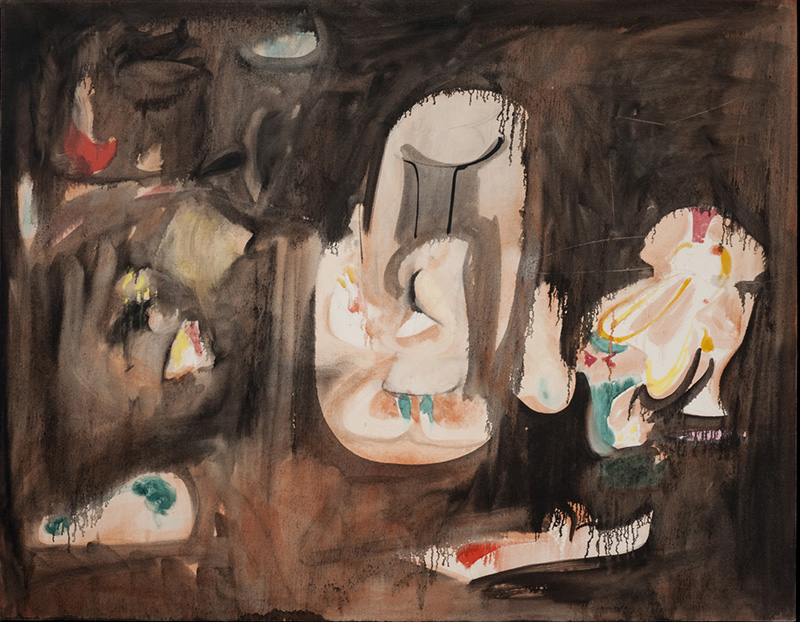ART-PRESENTATION: Arshile Gorky-Ardent Nature
 Arshile Gorky’s contribution to the art-world is difficult to estimate. Most people have never even heard of the artist, but within the Abstract Expressionist Movement he was intensely well-known and popular. His mature sense of spontaneity was decades ahead of his time and influenced artists that followed in his footsteps. He pioneered Abstract Expressionism and inspired the New York School.
Arshile Gorky’s contribution to the art-world is difficult to estimate. Most people have never even heard of the artist, but within the Abstract Expressionist Movement he was intensely well-known and popular. His mature sense of spontaneity was decades ahead of his time and influenced artists that followed in his footsteps. He pioneered Abstract Expressionism and inspired the New York School.
By Efi Michalarou
Photo: Hauser & Wirth Gallery Archive
The exhibition “Ardent Nature. Arshile Gorky Landscapes, 1943-47” presents 50 landscapes, including paintings and works on paper, from a critical time in the artist’s life and work. Arshile Gorky’s breakthrough came in the summer of 1943, during an extended stay at Crooked Run Farm, the Virginia homestead owned by his wife’s parents. Here, the artist became enchanted by the landscape, and his response to the fields, blooms, patterns, and colors around him began to manifest in vibrant compositions. Gorky’s time at Crooked Run Farm marked a profound reawakening of his connection to nature. During his first summer in the countryside in 1943, Gorky spent day after day in the open pastures, producing scores of ‘plein air’ drawings. Infatuated with his surroundings, he discovered the complexities of natural forms. It was here, among the flora and fauna, that Gorky revisited his early experiments with automatic drawing, courting free associations with nature and its endless metamorphoses. Returning to sometimes idealized memories of his early life on the shores of Lake Van, in Ottoman Anatolia, Gorky incorporated fragments from his childhood into the reality of his surroundings. In this conflation of truth, memory, and desire, the observational yields to an essence rendered in vivid, incandescent auras that reverberate within outlined forms, as seen in “Waterfall” (ca. 1943), on loan from the Hirshhorn Museum and Sculpture Garden. In Gorky’s work on paper, “Untitled (Virginia Landscape)” (1943) biomorphic symbols, swollen and rounded, allude to botanical or human sex organs, and are complemented with wiry lines evocative of vines or stamen. In his later work, such as the masterful “Gray Drawing for Pastoral” (ca.1946-1947), these instinctive symbols harden into something of a personal vocabulary comprised of distinct recurring forms. Arshile Gorky was born Vosdanig Adoian in the Armenian province of Van on the eastern border of Ottoman Turkey. His father fled to the United States in 1908 to avoid conscription, but the family stayed behind and suffered amid the increasing Ottoman Turkish persecution of Armenians. In the face of hardship, Gorky’s mother encouraged the budding artist by introducing him to Armenian art and architecture. In 1915 the family endured a harrowing 100-mile forced march, and in 1919 Gorky’s mother, suffering from malnutrition, died in her son’s arms. The next year Gorky and his younger sister managed to escape to the United States. After living with relatives in New England (including briefly with his father, where he found the photograph that would later become the basis for “The Artist and His Mother” Gorky settled in New York City in 1924. Intent on reinventing himself, he adopted the name Arshile Gorky. He enrolled at the National Academy of Design and the Grand Central School of Art, where he became an instructor. He counted among his New York friends the artists Stuart Davis and Willem de Kooning. Though he had some formal art training, Gorky was largely self-taught. He haunted museums and galleries and devoured art books and magazines. He systematically studied and engaged with the work of Paul Cézanne, Pablo Picasso, and Joan Miró, among others, and his style developed over the years from cubism, to Post-Impressionism, to Surrealism. By the early 1940s Gorky had gained recognition as one of the most prominent abstract artists among the New York Avant-Garde. Gorky’s life ended as tragically as it had begun. A devastating studio fire in 1946 that destroyed more than 20 paintings and scores of drawings was quickly followed by a painful operation for cancer, a debilitating car accident, and the disintegration of his marriage. He hanged himself in 1948.
Info: Curator: Saskia Spender, Hauser & Wirth Gallery, 32 East 69th Street, New York, Duration: 2/11-23/12/17, Days & Hours: Tue-Sat 10:00-18:00, www.hauserwirth.com
